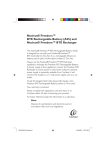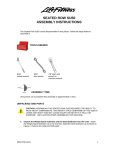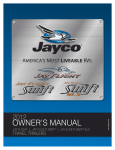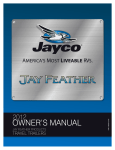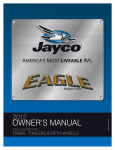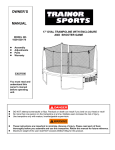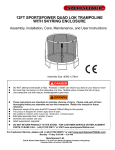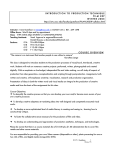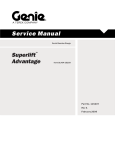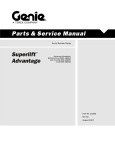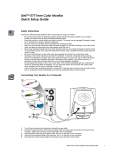Download Li`l Rocker Fifth Wheel Hitch System
Transcript
Li’l Rocker Fifth Wheel Hitch System Installation Instructions And User Guide T A B L E O F C O N T E N T S L R - 1 0 0 0 0 - 0 3 0 3 Contents INTRODUCTION..................................................................................................................................................... 2 LI’L ROCKER PARTS VIEW ................................................................................................................................. 3 UNPACKING YOUR LITTLE ROCKER ................................................................................................................ 4 HITCH HANDLE ASSEMBLY................................................................................................................................ 4 HITCH ASSEMBLY ................................................................................................................................................ 5 INSTALLATION NOTES........................................................................................................................................ 6 CHEVY/GMC STRAIGHT FRAME W/OUTSIDE SHOCKS.................................................................................. 7 CHEVY/GMC STRAIGHT FRAME W/INSIDE SHOCKS...................................................................................... 8 CHEVY/GMC W/TAPERED FRAME................................................................................................................... 10 CHEVY/GMC WITH BOX T UBE TYPE CHASSIS 1999 - PRESENT ................................................................ 11 DODGE FULL SIZE – ALL THROUGH 2002...................................................................................................... 12 DODGE FULL SIZE – 2003 - PRESENT ............................................................................................................. 14 FORD F-150 TO 1996; F-250/350 TO 1998 ........................................................................................................ 16 FORD F-150 1997-PRESENT; F-250/350 1999 – PRESENT ............................................................................ 17 ABOUT YOUR LI’L ROCKER.............................................................................................................................. 19 PREPARING FOR FIRST USE............................................................................................................................ 19 SIDE SWIVEL LOCK-OUT OPERATION............................................................................................................ 20 MAINTAINING YOUR LI’L ROCKER .................................................................................................................. 21 OBTAINING WARRANTY SERVICE................................................................................................................... 21 HITCH HEAD – EXPLODED VIEW ..................................................................................................................... 22 TROUBLESHOOTING ......................................................................................................................................... 23 LIMITED MILLION MILE WARRANTY................................................................................................................ 25 1 I N T R O D U C T I O N LR - 1 0 0 0 0 - 0 3 0 3 Introduction • RBW Industries Inc takes great pride in our reputation as an innovative manufacturer of high quality products. We have designed the Li’l Rocker Fifth Wheel Hitch System to provide a lifetime of dependable service. It’s extremely important to fully read and understand all steps of assembly, installation, operation and maintenance of your new Li’l Rocker Hitch System to assure safe, reliable operation. • Safety is of paramount importance in both installation and use of the Li’l Rocker Hitch System. Observe all cautions and notes found in this manual, as well as common sense precautions to ensure the safety of yourself and others. • Caution: The Li’l Rocker is recommended for use only in regular size truck beds. For short bed applications, RBW Industries, Inc. Hitch Model UHS-88-15 or UHS-88-15-S (Side Swivel) should be used in conjunction with the UHS-4800 Bed Slide Extensions. This will help prevent damage to the rear of the truck cab due to insufficient clearance. • For best results, RBW Industries, Inc. recommends you have your Li’l Rocker professionally installed by a qualified technician. • The RBW Industries, Inc. Li’l Rocker Fifth Wheel Hitch System is designed to tow 5 th Wheel Trailers with a Gross Vehicle Weight Rating up to 15,000 lbs. Exceeding the rated capacity is not recommended. • For ease in attaching the frame brackets, remove one side of the rear tires and block the rear axle. This will allow easy access to the truck frame. Caution: Make sure three wheels are firmly on the ground at all times and the axle is firmly supported to prevent injury from a falling truck. • Caution: Prior to drilling into the truck bed or frame for installation of the hitch mount, be sure to note the vicinity of brake, fuel or electrical lines. Temporarily relocate them if necessary to avoid possible damage. • Note: Due to variations in chassis suspension component locations it may be necessary to change long & short bracket locations. Always check for proper fit prior to installation. • Caution: On all installations there must be a minimum of 5-1/2” clearance between the bottom of the trailer nose and the top of the truck bedsides. This is to prevent damage to the truck, trailer or hitch due to lack of clearance. 2 A S S E M B L Y L R - 1 0 0 0 0 - 0 3 0 3 LR-10000 Li’l Rocker 15K Fifth Wheel Hitching System 3 A S S E M B L Y L R - 1 0 0 0 0 - 0 3 0 3 1 Chapter Unpacking and Assembly Unpacking: The Li'l Rocker Hitch Assembly ships in three boxes as indicated below. Inspect all parts for damage & verify that all items listed are present. Box 1 Contains: LR-1001 LI'L ROCKER HITCH HEAD (Qty 1) H-220/H-221 Hitch Handle w/Grip (Qty 1) Box 2 Contains: LR-302 2" x 3" Body Side Tube Assembly (Qty 2) LR-201 Cross member (Qty 1) LR-400 Hardware Bag (includes all hardware) (Qty 1) H-240 Short Frame Brackets (Qty 2) H-241 Long Frame Brackets (Qty 2) Box 3 Contains: LR-1020 Bed Rails (Qty 2) 2. Hitch Handle Assembly a) Grasp the hitch handle support bar and pull until the slide bar locks in the open position. Pull the handle support bar out another 1/4" so that the dowel pin is on the outside of the collar and rotate the handle support bar until the dowel pin is on the top side of the hitch head. 4 A S S E M B L Y L R - 1 0 0 0 0 - 0 3 0 3 b) With the hitch still in the open position, slide the hitch handle over the support shaft and orient so that the handle grip points in the opposite direction of the dowel pin. c) Fasten the hitch handle using the supplied bolt and nylock nut. d) Pulling out slightly on the handle, rotate until the handgrip is pointing upwards and allow the handle to move inward until the slide bar contacts the silver trip mechanism. Note: The handle should now be locked in position with the handgrip pointing upward. It will not point downward until the slide mechanism is in the closed position. Attempting to force it to tur n can cause damage to the handle mechanism. 3. Hitch Assembly a) Attach the hitch handle to the hitch head. (See hitch handle assembly) b) Place the bed rails (LR-1020) in the bed of the truck approximately 22" from each other. c) Place the main body support members into the bed rails with the decals facing the rear of the truck. Secure the main body support members to the bed rails using the ½ inch diameter clevis pins (H-246). Secure the clevis pins using the large hairclips (U-17) in the hardware bag. Note: Each of the rear facing footpads (decal end) on the main body support members has a rounded or ground off edge. For proper fit into the bed rails, this edge must be on the outside and to the rear of the vehicle when placing the main body support members into the bed rails. d) Locate the weld spot on the center of the crossbar and orient the crossbar so the weld spot faces the rear of the vehicle. Select the desired height and bolt the adjustable yoke crossbar to the main body supports using the ¾” bolts (H-242) & nylock nuts (80-N). Note: Be sure that the crossbar straddles the main body supports. Torque the bolts to 65 ft lbs. Do not over tighten, as this will cause the body assembly to fit improperly in the bed rails. e) Place the hitch head onto the adjustable yoke crossbar and secure with the supplied 3/8” clevis pins (KP-CP) and hairclips (KP-HP). Check for freedom of movement. f) The Li’l Rocker Fifth Wheel Hitch System is now ready for installation. 5 I N S T A L L A T I O N L R - 1 0 0 0 0 - 0 3 0 3 2 Chapter Installation Procedures General Installation Notes • Caution: The center of the hitch must be at least 52” from the rear of the cab in order to prevent damage to the tow vehicle and/or coach due to insufficient clearance. • Note: Always mount the frame attachment leg of the frame bracket on the outside of the frame. • Note: Due to variations in chassis suspension component locations it may be necessary to swap long & short frame bracket locations. Always check for proper fit prior to installation. • Note: The ideal location of the center of the hitch is 2” ahead of the axle. Some applications do not allow this due to spring/shock mount location. In these instances the hitch location may be adjusted fore or aft, but no further aft than centered over the axle. Caution: Moving the hitch too far forward will limit the turning radius of the truck/coach combination. • Note: If a plastic bed liner is installed, the bed liner must be cut out to accommodate the bed rails. This will allow the bed rails to be mounted flush against the bed, and allows installation of required spacers between the bed and bed rails. • Note: Always use spacers H-247 & H-248 to eliminate the risk of crushing or damaging the truck bed. This is especially important with composite truck beds. • Note: Torque all hardware to 65 ft. lbs. If you have questions regarding the installation or use of our products, please call our Technical Assistance Department at 800-451-7821, Weekdays between 8:00 AM and 5:00 PM (Pacific). 6 I N S T A L L A T I O N L R - 1 0 0 0 0 - 0 3 0 3 Chevrolet/GMC Straight Frame/Outside Shock Absorbers/34” Frame (Figure 1-2) 1. From underneath the truck, locate the bed support rail that is approximately 12” ahead of the axle. Using a center punch, punch a mark on the underside of the bed at the center of each end of the bed support rail. Working from the top of the truck bed, draw a line across the top of the truck bed connecting the two punch marks. 2. Center the assembled hitch between the fender wells . Position the center of the holes in row two over the line previously drawn in the truck bed. (Row one is closest to the cab) 3. Using a center punch, mark the location of the eight holes for the bed rail to bracket carriage bolts as follows: Row 1 - Holes “B”; Row 2 - Holes “A”; Row 3 - Holes “D”; Row 4 - Holes “A”. Check to see if the long brackets will fit at row 1. Adjust the hitch accordingly. Mark new bolt hole locations if needed. 4. Once the hitch location & fit have been determined, using the punch marks as a guide, drill eight holes through the bed. Holes for row 3 will be drilled through the bed and bed support rail. 5. Install the provided spacers above or below the bed to fill in the corrugations at the boltholes for row 1. Install the carriage bolts through the bed rails, spacers & bed. Install the long frame brackets loosely onto the carriage bolts. Snug the frame bracket against the frame & bed and clamp firmly in place. Selecting holes that give the greatest spread; mark the location of two boltholes for each bracket onto the frame. Drill holes through the frame. 6. Secure the front frame brackets to the frame using the supplied hardware. 7. At row 4, install the spacer with the ½” hole between the frame bracket and bed. Install the ½” flat washers, lock washers and nuts. Snug frame bracket against bed & frame & clamp into place. Selecting holes that give the greatest spread; mark the location of two boltholes for each bracket onto the frame. Drill holes through the frame. 8. Secure the rear frame brackets to the frame using the supplied hardware. 9. At the 4 remaining holes install the remaining carriage bolts, spacers, washers & nuts. 7 I N S T A L L A T I O N L R - 1 0 0 0 0 - 0 3 0 3 Chevrolet/GMC Straight Frame/Inside Shock Absorbers/34” Frame (Figure 3-4) 1. From underneath the truck, locate the bed support rail that is approximately 12” ahead of the axle. Using a center punch, punch a mark on the underside of the bed at the center of each end of the bed support rail. Working from the top of the truck bed, draw a line across the top of the truck bed 1/8” forward of the two punch marks. 2. Center the assembled hitch between the fender wells. Position the center of the holes in row two over the line previously drawn in the truck bed. (Ro w one is closest to the cab) 3. Using a center punch, mark the location of the eight holes for the bed rail to bracket carriage bolts as follows: Row 1 - Holes “B”; Row 2 - Holes “A”; Row 3 - Holes “A”; Row 4 - Holes “B”. Check to see if the long brackets will fit at row 1 and the short brackets at row 4. Adjust the hitch accordingly. Mark new bolt hole locations if needed. 8 I N S T A L L A T I O N L R - 1 0 0 0 0 - 0 3 0 3 4. Once the hitch location & fit have been determined, using the punch marks as a guide, drill eight holes through the bed. 5. Install the provided spacers above or below the bed to fill in the corrugations at the boltholes for row 1. Install the carriage bolts through the bed rails, spacers & bed. Install the long frame brackets loosely onto the carriage bolts. Snug the frame bracket against the frame & bed and clamp firmly in place. Selecting holes that give the greatest spread; mark the location of two boltholes for each bracket onto the frame. Drill holes through the frame. 6. Secure the front frame brackets to the frame using the supplied hardware. 7. At row 4, install the ½” flat washers, lock washers and nuts. Snug the short frame brackets against bed & frame & clamp into place. Selecting holes that give the greatest spread; mark the location of two boltholes for each bracket onto the frame. Drill holes through the frame. 8. Secure the rear frame brackets to the frame using the supplied hardware. 9. At the 4 remaining holes install the remaining carriage bolts, spacers, washers & nuts. 9 I N S T A L L A T I O N L R - 1 0 0 0 0 - 0 3 0 3 Chevrolet/GMC with Tapered Frame (Figure 5-6) 1. Locate the bed support rails under the truck by sighting across the top of the bed looking for spot welds that fasten the bed support rails to the bed. (These look like dimples and are about 3/8” in diameter and there are 2 rows of welds for each bed support rail.) The front bed support is approximately 15 inches ahead of the axle. Draw a line across the bed ½” forward of the center of the rear row of spot welds. 2. Center the assembled hitch between the fender wells. Locate the front edge of the front bed rail on the line drawn across the bed. 3. Using a center punch, mark the location of the eight bolt holes as follows: Row 1 - Holes “B”; Row 2 - Holes “B”; Row 3 - Holes “C”; Row 4 - Holes “C”. Check to see if the long frame brackets will fit at row 2 and the short frame brackets fit at row 4. Adjust the hitch accordingly. Mark new bolt hole locations if needed. 4. Once the hitch location & fit have been determined, using the punch marks as a guide, drill eight holes through the bed. 10 I N S T A L L A T I O N L R - 1 0 0 0 0 - 0 3 0 3 5. Install the provided spacers above or below the bed to fill in the corrugations at all bolt holes. Install the carriage bolts through the bed rails, spacers & bed. 6. Under the bed, place the long brackets, flange facing in, onto the carriage bolts in row 2 and short brackets, flange facing in, onto the carriage bolts in row 4. Snug the short frame brackets against bed & frame & clamp into place. Selecting holes that give the greatest spread; mark the location of two boltholes for each bracket o nto the frame. Drill holes through the frame. 7. Secure the rear frame brackets to the frame using the supplied hardware. 8. At the 4 remaining holes install the remaining carriage bolts, spacers, washers & nuts. Chevy/GMC With Box Tube Type Chassis 1999 – Present (Figure 13-14) 1. Note: These instructions require the use of bracket kit # P-183. 2. Locate the hitch approximately 2” forward of the rear axle centerline. Center the assembled hitch between the fender wells. 3. Using a center punch, mark the location of the eight bolt holes as follows: Row 1 - Holes “A”; Row 2 Driver Side - Hole “A”; Row 2 Passenger Side - Hole “A”; Row 3 - Holes “A”; Row 4 Holes “A”. Check to see if the frame brackets will fit at row 2 and row 4. Adjust the hitch accordingly. Mark new bolt hole locations if needed. 4. Once the hitch location & fit have been determined, using the punch marks as a guide, drill eight holes through the bed. 5. Install the provided spacers above or below the bed to fill in the corrugations at all bolt holes. Install the carriage bolts through the bed rails, spacers & bed. 6. Under the bed, place the long brackets, flange facing in, onto the carriage bolts in row 2 and short brackets, flange facing in, onto the carriage bolts in row 4. Snug the short frame brackets against bed & frame & clamp into place. Selecting holes that give the greatest spread; mark the location of two boltholes for each bracket onto the frame. Drill holes through the frame. Note: It will be necessary to fish the bolts for the front bracket to chassis connections. This is due to box type construction of the chassis. 7. Secure the frame brackets to the frame using the supplied hardware. 8. At the 4 remaining holes install the remaining carriage bolts, spacers, washers & nuts. 11 I N S T A L L A T I O N L R - 1 0 0 0 0 - 0 3 0 3 Dodge Full Size – All Through 2002 (Figure 7-8) 1. Determine if there is a brake equalizer valve on the roadside chassis leading to the rear wheels. If so equipped, remove the nuts that hold the valve to the chassis. Move the valve away from the inside of the chassis. Caution: Do not disconnect any wires or tubing. Do not kink any lines leading to or from the valve. 2. Locate the front bed rail approximately 12" ahead of the rear axle. Lightly mark the bed of the truck bed at each end of the front edge of the bed rail. Draw a line across the truck bed 5/16" forward of the marks. 3. Center the assembled hitch between the fender wells and position the center of the holes in row 1 over the line drawn across the bed. 4. Using a center punch, mark the location of the eight bolt holes as follows: Row 1 - Holes “A”; Row 2 - Holes “A”; Row 3 - Holes “A”; Row 4 - Holes “A”. Check to see if the long frame brackets will fit at row 1 and the short frame brackets fit at row 4. Adjust the hitch accordingly. Mark new bolt hole locations if needed. Note: The long bracket for the curbside front will 12 I N S T A L L A T I O N L R - 1 0 0 0 0 - 0 3 0 3 mount to the chassis underneath the shock absorber mount. It may be necessary to use longer bolts (SAE Grade 5). 5. Once the hitch location & fit have been determined, using the punch marks as a guide, drill eight holes through the bed. 6. Install the provided spacers above or below the bed to fill in the corrugations at all bolt holes. Install the carriage bolts through the bed rails, spacers & bed. 7. Install the long frame brackets loosely onto the carriage bolts using ½” flat washers, lock washers and nuts. Snug the frame bracket against the frame & bed and clamp firmly in place. Selecting holes that give the greatest spread; mark the location of two boltholes for each bracket onto the frame. Drill holes through the frame. 8. Secure the front frame brackets to the frame using the supplied hardware. 13 I N S T A L L A T I O N L R - 1 0 0 0 0 - 0 3 0 3 9. At row 4 install the short frame brackets onto the carriage bolts using ½” flat washers, lock washers and nuts. Snug the short frame brackets against bed & frame & clamp into place. Selecting holes that give the greatest spread; mark the location of two boltholes for each bracket onto the frame. Drill holes through the frame. 10. Secure the rear frame brackets to the frame using the supplied hardware. 11. At the 4 remaining holes install the remaining carriage bolts, spacers, washers & nuts. 12. Reattach brake equalizer valve, if applicable. Dodge Full Size – 2003 Thru 2004 (Figure 15-16) Note: These instructions require the use of bracket kit # P-110. The chassis on these vehicles is a full-length box tube chassis. Based upon information received from the vehicle manufacturer, (Dodge Truck Engineering Bulletin No. 021), the following procedures meet Dodge requirements for installation. Be sure to observe the following: 1) Holes are not to be drilled in the top or bottom of the frame rails. Holes to mount brackets must be drilled in the web (vertical sides) of the frame rail with the following restrictions: a) Hole diameter should not exceed 20mm (0.75 in.). b) Material between edge of hole and top or bottom of frame rail must not be less than 40mm (1.60 in.). c) The minimum edge distance between any two (2) holes must be larger than twice the diameter of the larger hole. d) All holes should be drilled in the frame using appropriate drilling practice and safety precautions. e) Avoid drilling holes near the fuel tank, fuel and brake lines and other lines and wires to avoid damage to them. 2) Prior to any welding, the following must be done: a) Avoid welding near the fuel tank, fuel and brake lines or other components that may be damaged by the heat of welding. If it is necessary to weld near these areas, use wet cloths to cover these components. If it is necessary to remove the fuel tank, lines or other components, do it in accordance with applicable service manual procedure. b) Components near the welding area which could be damaged by excessive heat must be removed or adequately shielded. c) Disconnect the battery(ies). d) Precautionary measures should be used to prevent electrical system components or wiring damage. e) Frame e-coating must be removed from the welding and surrounding area. f) Use proper welding techniques to avoid stress risers that may adversely affect frame performance. 3) After welding: a) Carefully inspect electrical components and wiring for shorts or other damage. b) Apply protective coating to areas where coating was removed. 14 I N S T A L L A T I O N L R - 1 0 0 0 0 - 0 3 0 3 Installation 1. Locate the second row of spot welds in the truck bed to the front of the axle. Draw a line across the truck bed 5/8” to the front of the spot welds. 2. Center the assembled hitch between the fender wells and position the center of the holes in row 2 over the line drawn across the bed. This should place the centerline of the hitch approximately 2 1/2” ahead of the axle centerline. 3. Using a center punch, mark the location of the eight bolt holes as follows: Row 1 - Holes “B”; Row 2 - Holes “B”; Row 3 - Holes “B”; Row 4 - Holes “B. Verify the rear bed rail straddles the rear bed support. Adjust as necessary for proper fit and re-mark bolt hole locations if needed. 4. Once the hitch location & fit have been determined, using the punch marks as a guide, drill eight holes through the bed. 5. Install the provided spacers above or below the bed to fill in the corrugations at all bolt holes. Install the carriage bolts through the bed rails, spacers & bed. Under the bed, place the brackets, flatbar pointing in, against the outside wall of the chassis at rows 2 and 3. Snug the brackets against the underside of the bed and the wall of the chassis and clamp into place. 15 I N S T A L L A T I O N L R - 1 0 0 0 0 - 0 3 0 3 Selecting holes in the leg of the bracket that give the greatest spread, mark the location of two bolt holes for each bracket onto the frame. Remove the bracket and drill the holes through the attachment wall only. Do not drill completely through the chassis. Fish the bolts through the chassis using the access holes at the top or bottom of the chassis and reattach the brackets to the chassis and bed using the supplied hardware. 6. At the 4 remaining holes in the bed, install the remaining carriage bolts, spacers, washers & nuts. 7. Torque all hardware to 65-ft. lbs. Ford (F-150 Through 1996) (F-250/350 Through 1998) (Figure 9-10) 1. From underneath the truck, locate the bed support rail approximately 14" ahead of the rear axle. Using a center punch, mark the underside of the truck bed at the forward end of the bed support rail. Draw a line across the truck bed 1 1/2" ahead of the marks in the bed. Note: This dimension is important to allow clearance between the frame mount bracket and the front edge of the bed support rail, and clearance behind the bed support rail for the carriage bolt. 2. Center the assembled hitch between the fender wells and position the center of the holes in row 1 over the line drawn across the bed. 3. Using a center punch, mark the location of the eight bolt holes as follows: Row 1 - Holes “A”; Row 2 - Holes “A”; Row 3 - Holes “A”; Row 4 - Holes “A”. Check to see if the long frame brackets will fit at row 1 and the short frame brackets fit at row 4. Adjust the hitch accordingly. Mark new bolt hole locations if needed. Note: On some applications it may be necessary to attach the short frame brackets to row 3 instead of row 4. 4. Once the hitch location & fit have been determined, using the punch marks as a guide, drill eight holes through the bed. 5. Install the provided spacers above or below the bed to fill in the corrugations at all bolt holes. Install the carriage bolts through the bed rails, spacers & bed. 6. Install the long frame brackets loosely onto the carriage bolts using ½” flat washers, lock washers and nuts. Snug the frame bracket against the frame & bed and clamp firmly in place. Selecting holes that give the greatest spread; mark the location of two boltholes for each bracket onto the frame. Drill holes through the frame. 7. Secure the front frame brackets to the frame using the supplied hardware. 8. At row 4 install the short frame brackets onto the carriage bolts using ½” flat washers, lock washers and nuts. Snug the short frame brackets against bed & frame & clamp into place. Selecting holes, which give the greatest spread; mark the location of two boltholes for each bracket onto the frame. Drill holes through the frame. Note: On some applications it may be necessary to attach the short frame brackets to row 3 instead of row 4. 16 I N S T A L L A T I O N L R - 1 0 0 0 0 - 0 3 0 3 9. Secure the rear frame brackets to the frame using the supplied hardware. 10. At the 4 remaining holes install the remaining carriage bolts, spacers, washers & nuts. Ford (F-150 1997 - Present) (F-250/350 1999 - Present) (Figure 11-12) 1. From underneath the truck, locate the bed support rail approximately 16" ahead of the rear axle. Using a center punch, mark the underside of the truck bed at the forward end of the bed support rail. Draw a line across the truck bed 3/4" ahead of the marks in the bed. 2. Center the assembled hitch between the fender wells and position the center of the holes in row 1 over the line drawn across the bed. 3. Using a center punch, mark the location of the eight bolt holes as follows: Row 1 - Holes “A”; Row 2 - Holes “B”; Row 3 - Holes “A”; Row 4 - Holes “A”. Check to see if the short frame brackets will fit at row 2 and the long frame brackets fit at row 4. Adjust the hitch accordingly. Mark new bolt hole locations if needed. 17 I N S T A L L A T I O N L R - 1 0 0 0 0 - 0 3 0 3 4. Once the hitch location & fit have been determined, using the punch marks as a guide, drill eight holes through the bed. 5. Install the provided spacers above or below the bed to fill in the corrugations at all bolt holes. Install the carriage bolts through the bed rails, spacers & bed. 6. Install the short frame brackets loosely onto the carriage bolts using ½” flat washers, lock washers and nuts. Snug the frame bracket against the frame & bed and clamp firmly in place. Selecting holes that give the greatest spread; mark the location of two boltholes for each bracket onto the frame. Drill holes through the frame. 7. Secure the front frame brackets to the frame using the supplied hardware. 8. At row 4 install the long frame brackets onto the carriage bolts using ½” flat washers, lock washers and nuts. Snug the short frame brackets against bed & frame & clamp into place. Selecting holes that give the greatest spread; mark the location of two boltholes for each bracket onto the frame. Drill holes through the frame. Note: On some applications it may be necessary to attach the long frame brackets to row 3 instead of row 4. 9. Secure the rear frame brackets to the frame using the supplied hardware. 10. At the 4 remaining holes install the remaining carriage bolts, spacers, washers & nuts. 18 O P E R A T I O N A N D M A I N T E N A N C E LR - 1 0 0 0 0 - 0 3 0 3 3 Chapter Li’l Rocker Operation and Maintenance RBW Industries Inc takes great pride in our reputation as an innovative manufacturer of high quality products. We have designed the Li'l Rocker Fifth Wheel Hitch System to provide a lifetime of dependable service. Following the operating instructions and performing the easy maintenance steps listed below will help you get the most out of your investment. About Your Li’l Rocker The RBW Industries Li'l Rocker Fifth Wheel Hitch System is designed to tow 5th Wheel Trailers with a Gross Vehicle Weight Rating up to 15,000 lbs. Exceeding the rated capacity could create an unsafe towing condition and is not recommended. It has a 4-way swivel head with side swivel lockout, is height adjustable from 12.5 to 15.5 inches in one-inch increments, and is removed from the bed of the truck by pulling 4 retaining pins. Preparing For First Use Your Li’l Rocker is now installed and you’re anxious to be on your way down the road. You’re almost there, but take a few minutes to ensure your hitch is setup properly for your particular truck/coach combination by following the steps below. 1. Verify the crossbar is set at the proper height to provide a minimum of 5-1/2” clearance between the bottom of the trailer nose and the top of the truck bedsides, and allows for a level-towing attitude of the coach. If necessary, adjust the crossbar to the proper height, ensuring the fasteners are re-torqued to 65 ft. lbs. 2. Ensure the coach wheels are blocked front & rear & that the rear stabilizer jacks are fully retracted. 3. Level the coach so that the bottom plate of the kingpin box is level with the tabletop or “horseshoe” plate on the top of the hitch head. 4. Rotate the handle of the hitch 180 degrees so that the handgrip is pointing straight up & pull the handle out until the slide bar is held open by the silver trip mechanism. 5. Slowly back the truck so that the bottom plate of the kingpin box slides onto the tabletop & the kingpin slides fully into the throat of the hitch head. Set the parking brake of the truck & place the transmission into park. 6. Visually verify the slidebar has closed behind the kingpin and the kingpin box is resting on the tabletop. Positively lock the slidebar by rotating the handle clockwise so the handgrip is pointing straight down at the bed of the truck. 19 O P E R A T I O N A N D M A I N T E N A N C E LR - 1 0 0 0 0 - 0 3 0 3 7. Attach the electrical & breakaway connectors to the proper receptacles in accordance with your coach owner’s manual, remove the blocks from the wheels of the coach and double check that the hitch is properly attached to your coach. Once you arrive at your destination, follow these simple steps to properly uncouple your coach from your Li’l Rocker. 1. Block your coach wheels front & rear. 2. If necessary, start your truck & back up against the kingpin to relieve pressure on the slidebar. Set the parking brake, put the transmission into park and then turn off your vehicle. 3. Extend the front landing gear of the coach until the weight of the coach is just off of the tabletop of the hitch. Do not exceed 1/16” gap between the bottom plate of the kingpin box and the tabletop of the hitch. Caution: Raising the coach too high while still connected can damage the hitch head as well as components of your coach. Do not extend the rear stabilizers of the coach prior to or during uncoupling. 4. Disconnect the electrical and breakaway connectors in accordance with your coach owner’s manual. Rotate the handle of the hitch 180 degrees so that the handgrip is pointing straight up, then pull the slide bar all the way open until the dowel pin in the handle shaft is outside the handle shaft guide. Lock the hitch handle in the open position by rotating it clockwise 180 degrees until the handgrip is pointing down at the bed of the truck. 5. You are now ready to pull your truck slowly away from the coach. Side Swivel Lock-Out Operation Your Li’l Rocker Hitch System is equipped with a side swivel lock out feature. The side swivel is designed to help prevent difficulty uncoupling when the coach and truck are not level with each other side to side, which will cause the kingpin to bind if the side swivel were locked out. While driving the side swivel can be engaged or locked out, as preferred by the operator. If the side swivel is locked out, be sure to engage it before pulling into a campsite that may be uneven. Also, be sure to observe the following: 1. To allow the hitch head to swivel, raise the two levers out of the key way on the front of the hitch and rotate each lever towards the outside of the hitch so the levers point down, then push the levers back down into the key way to lock in place. 2. To lock out the side swivel, simply lift both levers out of the key way and rotate each lever towards the outside of the hitch so the levers point up, then push the levers back down into the key way to lock in place. 3. In some cases if the trailer is coupled you may not be able to rotate the levers to the extremes. The levers are spring-loaded and will drop into position when movement between the hitch body and hitch tabletop occurs while coupled. 4. To prevent damage to the hitch, ensure both side swivel levers are in the same position. 5. If the levers feel loose in the key way, turn the hitch head over and tighten the screw and nut holding the lever to the shaft of the lockout cam. 20 O P E R A T I O N A N D M A I N T E N A N C E LR - 1 0 0 0 0 - 0 3 0 3 Maintaining Your Li’l Rocker 1. After coupling, always visually check that the slide bar has closed completely across the rear of the kingpin. 2. After the first 100 miles, and at least once a year thereafter, inspect all bolts for proper tightness. Retighten bolts if needed. All fasteners should be torqued to 65 ft lbs. 3. Once or twice a week when traveling, apply a few drops of motor oil to the top of the pivot pin collar (H161). The pivot pins hold the tabletop or "horseshoe" in place on the hitch head and can be found by locating the hex head bolts on the front and rear of the hitch head. 4. Once or twice a year, apply a light coating of wheel bearing grease to the surfaces of the slide bar that holds the kingpin in place. For best results, apply the grease with the slide bar in the closed position. Caution: The slide bar can close with heavy force. Use extreme care to keep fingers, hands, extremities & clothing out of the path of the slide bar. Failure to do so could result in severe injury. 5. At least once a year, thoroughly clean and degrease the hitch head assembly. After cleaning, lubricate as mentioned above. 6. Periodically inspect your Li'l Rocker for wear or damage. If excessive wear or damage is found, contact RBW Industries Inc Technical Support Department for assistance at 800-451-7821. Obtaining Warranty Service Your warranty statement contains important information. Please take a few moments to turn to the rear cover of this guide and familiarize you with RBW Industries, Inc. warranty policy for your Li’l Rocker. For warranty assistance, contact Customer Support at 800-451-7821, Weekdays 8:00 AM to 5:00 PM (Pacific). 21 O P E R A T I O N & M A I N T E N AN C E L R - 1 0 0 0 0 - 0 3 0 3 LR-1001 Hitch Head Exploded View 22 T R O U B L E S H O O T I N G L R - 1 0 0 0 0 - 0 3 0 3 Troubleshooting Problem Hitch is difficult to install and remove from the bed rails. Hitch will not hook up to trailer kingpin. What To Look For Solution Hitch is not assembled correctly. Refer to Hitch Assembly section for proper assembly instructions. Bed Rails are not parallel with each other. Use a spacer to hold both bed rails parallel while loosening & retightening the carriage bolts. Truck bed collapsing around carriage bolts in bed rails. Install proper spacers between the bed rail and corrugations. Refer to installation instructions for specific directions. Incorrect kingpin height. The kingpin plate should be at the same height as the top of the hitch, or at most 1/16” higher. Excessive angle between hitch head and kingpin. Level trailer or tow vehicle with blocks under the wheels. (If not a side-swivel head) Disengage side-swivel lockouts. (If applicable) Hitch is difficult to unhook from trailer. Lube disc is too thick. Check thickness of lube disc. It should not exceed 3/16”. Bent kingpin. Contact your local dealer for replacement. Kingpin is resting on the locking bar, preventing it from sliding open. Remove pressure on the locking bar by blocking the trailer wheels in front and behind. With trailer wheels blocked & truck running, place truck in reverse, set the parking brake and then put truck into park and turn off the engine. This should relieve the pressure on the locking bar. Incorrect kingpin height. The kingpin plate should be at the same height as the top of the hitch, or at most 1/16” higher. Excessive angle between hitch head and kingpin. Level trailer or tow vehicle with blocks under the wheels. Disengage side-swivel lockouts. (If applicable) Locking bar is difficult to close or open. Lube disc is too thick. Check thickness of lube disc. It should not exceed 3/16”. Bent kingpin. Contact your local dealer for replacement. New hitch head. Contact RBW Technical Support for assistance. 23 T R O U B L E S H O O T I N G L R - 1 0 0 0 0 - 0 3 0 3 Locking bar is worn. Inspect locking bar for wear or damage. Look for a ridge at the front edge of the locking bar. If found, file away the ridge and lubricate locking bar. Contact RBW Technical Support if locking bar is damaged rather than worn. Lack of lubrication. Lubricate locking bar and pull handle with a light coating of grease on all contact surfaces. Missing spring on trip mechanism. Contact RBW Industries Technical Support for replacement spring. Missing or damaged trip mechanism. Inspect trip mechanism. The trip mechanism should not be bent & the spring should be attached & have good tension. Side swivel lockout cam handle does not stay locked in the keyway. Handle retaining screw & nut loose. Tighten screw & nut as instructed in the maintenance section of the owner's manual. Tabletop distorted/cracking at the pivot point. Wear & Tear Replace tabletop assembly and keep lubricated as instructed in the maintenance section of the owner's manual. Locking bar does not lock into the open position. 24 L R - 1 0 0 0 0 - 0 3 0 3 RBW INDUSTRIES, INC. LI’L ROCKER 15K FIFTH WHEEL HITCH SYSTEM LIMITED MILLION MILE WARRANTY RBW Industries, Inc. warrants the Li’l Rocker 15K Fifth Wheel Hitch System against defects in material and workmanship under normal use and service, ordinary wear and tear excepted, for one million miles from the first date of purchase at retail. Any part found to have a defect in material or workmanship, will be repaired or replaced at the option of RBW when returned to RBW with transportation charges prepaid. This warranty does not cover the condition, durability or appearance of the product finish. If the hitch is damaged as a result of improper installation, alteration, vehicle accident, misuse or unreasonable use, including but not limited to, loading the product beyond the factory rated load capacity, RBW shall not be required to repair or replace such product. In every case, this warranty covers only the defective part and does not provide for reimbursement of the retail price of the part or labor charges. RBW shall not be liable for any incidental or consequential damages for breach of any express or implied warranty on any RBW product. There are no warranties that extend beyond the description of the face hereof. RBW is extending no other warranties, express or implied, nor any warranties of merchantability or fitness for a particular purpose. Any such warranties of merchantability or fitness for a particular purpose are expressly excluded. This warranty is designed and intended to fully comply with the requirements of the Magnusson-Moss Warranty Act and all regulations issued by the Federal Trade Commission in connection therewith. It is not intended to violate any state law or regulation containing more stringent requirements, and such requirements automatically become part of this warranty insofar as required by that act. The owner has available the legal remedies provided by the Magnusson-Moss Warranty Act, Public Law 93-637, 99 STAT.2183-2193: 15 U.S. Code, Secs 23021-2312, and any applicable state statutes. RBW INDUSTRIES, INC. 5740 Schaefer Avenue • Chino, CA 91710 909.591.8279 • 800.451.7821 • Fax 909.591.6730 www.rbwindustries.com 25


























